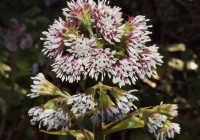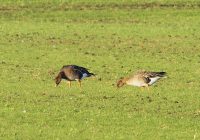Dr Phil Smith’s Wildlife Notes
January 2012
Some rain fell on about 15 days during the month but two prolonged dry periods meant little improvement in the dune water-table, which remained worryingly low. Devil’s Hole at Ravenmeols is usually well flooded by January but a visit on 10th revealed no water at all. The edges of this large blow-out had been sculptured into fantastic shapes by the December gales, reminiscent of the desert landscapes of Arizona or North Africa. Cabin Hill National Nature Reserve was also much dryer than usual. By the end of the month, I estimated the water-level in the main slack to be about 20cm below the winter average. Not surprisingly, I counted only 15 Snipe there.
Although January ended with a cold snap, much of the month continued this winter’s mild theme and I received several reports reflecting this. For example, Patricia Lockwood had Sweet Violet flowering in her Freshfield garden as early as the 13th, while Brian Wilby found Lesser Celandine at Aughton on 19th. Snowdrops were in full flower at St Luke’s Church on 25th and I was pleased to find both Yellow and Early Crocus on Hightown dunes at the end of the month. An early Common Frog made an appearance in Rachael Parks’ Formby garden on 23rd, while on the same day she saw a Seven-spot Ladybird. Martin Mere produced the first Peacock butterfly of the year on 25th.
On 11th, I stopped off in Ince Blundell Woods to check the long-standing colony of Winter Heliotrope on the road-side. There were plenty of feathery pink flower-spikes among the characteristic rounded leaves. This native of the Mediterranean region was introduced into gardens in 1806 but has since become widely naturalised, though rather uncommon in our region. It normally flowers between December and March, attracting pollinating insects by means of a characteristic vanilla-like fragrance.
In the December notes, I mentioned I had failed to find a wintering Glaucous Gull at Birkdale. After several more visits, I finally caught up with this first-winter bird off Weld Road on 11th, though it was soon flushed by a dog-walker. Two days later, John Dempsey located another Glaucous Gull at Birkdale, this time a large second-winter bird. Unfortunately, this one eluded me, as did a beached Common Seal that John found on 23rd. This rare visitor to our shores soon returned to the sea in an apparently healthy condition.
On 15th, following up a report by Graham Clarkson, I got excellent views of a flock of 110 Twite on the shore opposite Southport Marine Lake where they were feeding on Glasswort seeds. Nearby, the Marshside/Crossens area still had Whitefronted and Barnacle Geese from time to time, while a Great Skua reported on 23rd was a much rarer visitor. An immaculate pair of Gadwalls in front of the hide posed for photographs.
Hearing Pink-footed Geese flying over my home morning and evening alerted me to the presence of a flock feeding nearby on Downholland Moss. Several visits between 18th and 22nd were rewarded with great views of between 3000 and 8000 geese. Working through them with a telescope from the car eventually produced groups of four, three and two Tundra Bean Geese, representing two family parties and a pair. As I have mentioned before, this species is quite hard to find amongst large numbers of Pinkfeet, the main distinguishing features being orange legs (not always visible) and an orange band on the bill. Coincidentally, Martin Mere reported ten Tundra Beans on 15th, this being their largest number ever. In fact, Martin Mere had a particularly good month. Apart from the usual Whooper Swans, which peaked at about 1800, a fine selection of raptors included up to seven Marsh Harriers, a Hen Harrier, several Buzzards and two Peregines, as well as Merlin, Sparrowhawk and Kestrel. Their best bird, however, was a Cetti’s Warbler, new to the reserve, on 25th and 28th. Of the handful of Lancashire records since the first in 1990, most have been in winter and have usually stayed around for some weeks.




